Search Research & Specialization
The Cancer Treatment Challenge
Current Treatment Limitations
Cancer treatment has historically relied on non-specific methods like chemotherapy, which affects both healthy and cancerous rapidly dividing cells, leading to significant side effects. Recent developments in precision medicine focus on molecularly targeted therapies, yet they encounter limitations such as tumor heterogeneity and delivery challenges. To overcome these issues, innovative strategies like synthetic biology are being explored. For example, Zhang et al. (2024) demonstrated how algae-based carriers exploiting photosynthesis can reduce tumor interstitial fluid pressure (IFP), enhance drug penetration, and alleviate hypoxia, thereby improving therapeutic outcomes. This approach addresses the physical barriers of drug delivery effectively. In addition, advances in genetic circuits and RNA biosensors offer promising solutions for tumor-specific diagnostics and therapeutics. Baabu et al. (2022) developed a comprehensive computational pipeline for designing RNA biosensors based on toehold switches, which can detect specific miRNA biomarkers of cervical cancer. These engineered biosensors exhibit high specificity and sensitivity, enabling point-of-care diagnostics that could replace invasive tests like Pap smears. Furthermore, the design of tumor-specific gene circuits with immune modulators provides a versatile platform for targeted immunotherapy. Nissim et al. (2017) presented synthetic gene circuits that enable precise, tumor-specific expression of immunostimulatory molecules, such as cytokines and immune checkpoint inhibitors, which enhance T cell responses while minimizing off-target effects. Their modular and programmable system can be adapted for different cancer types and combined with existing therapies to improve efficacy.
Clinical Data (RSUD Dr. Pirngadi Medan, 2021-2023):
Chemotherapy in breast cancer patients showed severe side effect: nausea-vomiting (30.1%), alopecia (28.1%), anemia (19%), and neutropenia (7.8%)
Existing Treatment Approaches
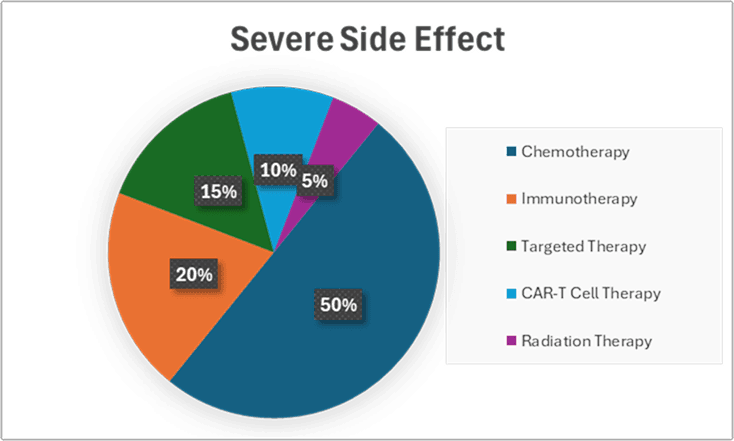
Comparative Profile of Side Effects from Cancer Treatments
Comparative Profile of Side Effects from Cancer Treatments
| Treatment Method | Severe Side Effect | Common Manifestation |
|---|---|---|
| Chemotherapy | 50% | Nausea-vomiting, hair loss, anemia |
| Immunotherapy | 20% | Autoimmune reactions, fatigue, diarrhea |
| Targeted Therapy | 15% | Milder and more controlled due to specific binding mechanism |
| CAR-T Cell Therapy | 10% | Cytokine release syndrome, neurotoxicity |
| Radiation Therapy | 5% | Damage to healthy tissues surrounding treatment area (Maani, 2022) |
FDA-Approved Precision Therapies
- 1.Keytruda (Pembrolizumab):Keytruda (Pembrolizumab) is a PD-1 inhibitor monoclonal antibody that enhances immune response against various cancers including melanoma and lung cancer.
- 2.Yescarta (Axicabtagene ciloleucel):Yescarta (Axicabtagene ciloleucel) is a CAR-T therapy that genetically modifies patient T cells to specifically target CD19-positive B cell lymphomas.
- 3.Kymriah (Tisagenlecleucel):Kymriah (Tisagenlecleucel) is another CAR-T therapy approved for pediatric and young adult B-cell acute lymphoblastic leukemia.
- 4.Herceptin (Trastuzumab):Herceptin (Trastuzumab) targets HER2 receptors on breast cancer cells and blocks cancer growth signals.
Critical Question: How can we develop therapeutic tools that are truly precise and tumor-specific while minimizing harm to healthy tissues?
Precision Medicine: Current Innovation
Key Technologies in Development
- 1.Toehold Switch:(RNA-based genetic switches that enable precise detection of cancer-specific biomarkers and controlled therapeutic gene expression. These synthetic regulators can sense tumor microenvirontment signals and trigger targeted responses (Baabu et al., 2022).
- 2.Immuno-Arsenal Approaches:engineering immune cells with synthetic circuits to enhance tumor recognition and killing capacity. Includes synthetic Notch receptor, logic-gated CAR-T cells, and programmable cytokine delivery systems (Nissim et al., 2017).
- 3.Genetic Switches:programmable biological circuits that respond to tumor-specific condition (pH, hipoxia, specific antigens) to activate therapeutic payloads only at tumor sites (Zhang et al., 2024).
Critical Gaps in Current Technologies
Current Condition
- 1.Hypoxia condition:most therapies fail in oxygen-depleted tumor environments. Cancer cells thrive in hypoxic conditions while therapeutic agents lose effectiveness (Chen et al., 2023).
- 2.Lack of Precision/Targeting: current systems struggle with off-target effect and cannot distinguish between similar cell types, leading to healthy tissue damage (Chen et al., 2023).
- 3.Delivery Strategy Issues inability:to effectively reach metastatic sites, poor tumor penetration, and inadequate payload deliverey systems limit therapeutic efficacy (Zhang et al., 2024).
Comparative Solution Analysis
Comparison analysis between current developed cancer therapy
| Technology | Hypoxia Tolerance | Precision / Targeting | Delivery (METASTASIS) |
|---|---|---|---|
| Toehold Switches | Cannot solve hypoxia problem | High specificity via RNA sensing | No delivery mechanism |
| Immuno-Arsenal | Immune cells fail in hypoxia | Antigen-specific targeting | Limited metastasis tracking |
| Microalgae Platform | Generates oxygen via photosynthesis | Non-specific accumulation | Active tumor-seeking motility |
| Our Integrated System | Solve hypoxia + sensing | Dual targeting mechanism | Delivers to metastatic sites |
Our Innovation
By integrating toehold switches, imuno-arsenal components, and microalgae as delivery platform, we address all three critical limitations simultaneously :
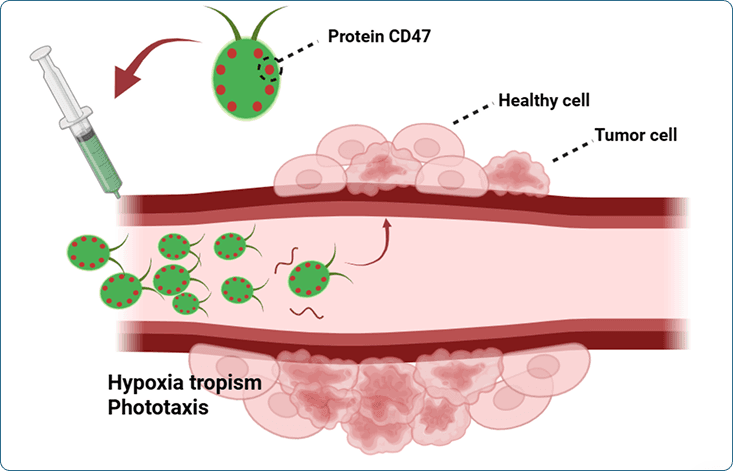
Systemic administration, tumor homing and immune engagement
Intravenous injection of the engineered microalgae (coated/modified for immune evasion, e.g., CD47 display) enables circulation and homing to hypoxic tumor sites through chemotaxis/phototaxis; upon accumulation and circuit activation, the microbes modulate the tumor microenvironment and recruit immune effector cells.
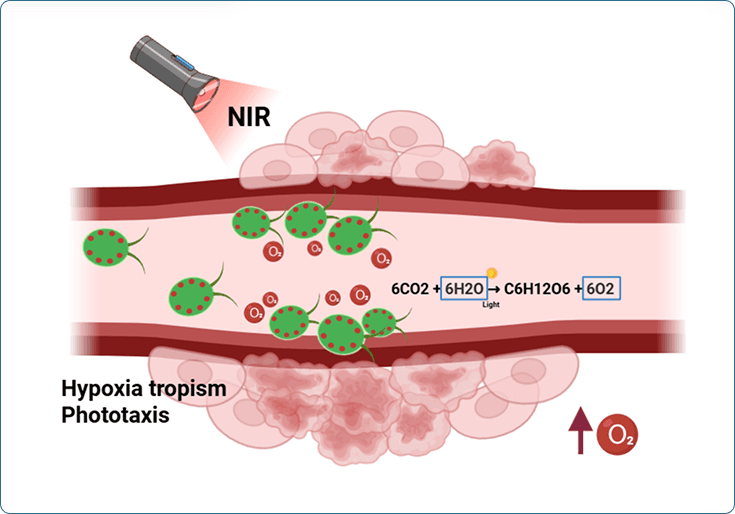
Light-activated oxygen generation to recondition hypoxic tumor niches
NIR (near-infrared) or light stimulation of photosynthetic microalgae increases local O₂ production within hypoxic tumor vasculature, improving oxygenation of the tumor core and potentiating oxygen-dependent therapies.
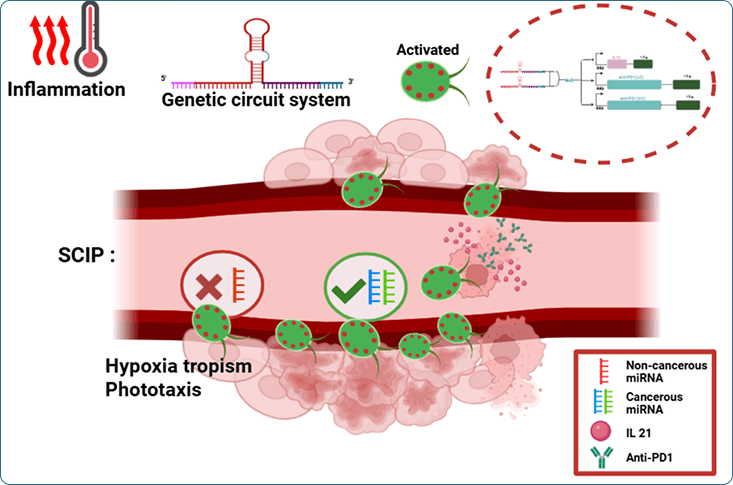
Inflammation-responsive genetic circuit releasing immuno-arsenal
An inflammation-sensing genetic circuit (toehold / RNA logic + thermal or inflammatory switch) activates engineered microalgae to locally secrete an immuno-arsenal (e.g., IL-21 and anti-PD-1), selectively stimulating anti-tumor immunity while minimizing systemic exposure.
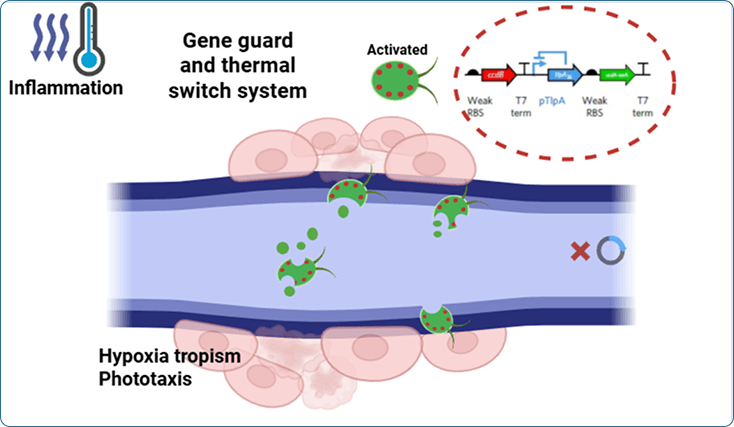
Tumor-triggered activation of gene-guarded microalgae
Microalgae engineered with a temperature- and gene-guard genetic switch traffic toward tumor tissue via hypoxia tropism and phototaxis; the genetic circuit remains OFF in normal tissues and is specifically activated in the tumor microenvironment.
References
Akbarali H.I., et al. (2022). Chemotherapy-induced gastrointestinal toxicities. Frontiers in Pharmacology, 13, 750507. https://pmc.ncbi.nlm.nih.gov/articles/PMC10033220/
Baabu, P. R. S., et al. (2022). End-to-end computational design of RNA biosensors for cervical cancer miRNA biomarkers. Synthetic and Systems Biotechnology, 7, 802–814.
Dashonville O., Bozec A., Fischel L., J. et al. (2007). EGFR targeting therapies: Monoclonal antibodies versus tyrosine kinase inhibitors: Similarities and differences. Critical Review In Oncology, 62(1), 53–61.
Deshmukh, S. K. (2020). CTLA-4 and PD-L1/PD-1 pathways: Immune checkpoint inhibitors and cancer immunotherapy. Journal of Cancer Immunology, 2(1), 10–12. https://www.scientificarchives.com/journal/journal-of-cancer-immunology
Chen, X., Li, S., Song, Y., & Yang, Y. (2023). Hypoxic microenvironment in cancer: Impact on therapy resistance and tumor progression. Signal Transduction and Targeted Therapy, 8(1), 112. https://doi.org/10.1038/s41392-023-01332-8
Fan, C., Wu, Y., Yang, Q., Yang, Y., Gong, B., et al. (2021). Identification of long non-coding RNAs involved in resistance to downy mildew in Chinese cabbage (Brassica rapa L.). BMC Plant Biology, 21, 409. https://doi.org/10.1186/s12870-021-03047-7
Green, A. A., et al. (2014). Toehold switches: de-novo-designed regulators of gene expression. Cell, 159(4), 925–939.
Haris Maruli (2021). Terapi Kanker, Jenis dan Efek Sampingnya. Primaya Hospital. https://primayahospital.com/bedah-onkologi/terapi-kanker/
Maani, E. V. (2022, Oktober 23). Radiation Therapy. In StatPearls. StatPearls Publishing. https://www.ncbi.nlm.nih.gov/books/NBK537036/
Nissim, L., Wu, M.-R., Pery, E., Binder-Nissim, A., Suzuki, H. I., Stupp, D., Wehrspaun, C., Tabach, Y., Sharp, P. A., & Lu, T. K. (2017). Synthetic RNA-Based Immunomodulatory Gene Circuits for Cancer Immunotherapy. Cell, 171(5), 1138–1150.e15. https://doi.org/10.1016/j.cell.2017.09.049
Sari, I. W., Rawitri, K., Dalimunthe, G. I., & Nasution, H. M. (2024). Gambaran efek samping obat kemoterapi pasien kanker payudara di RSUD Dr. Pirngadi Kota Medan. FARMASAINKES: Jurnal Farmasi, Sains, dan Kesehatan, 4(1), 14–20.
Zhang, X., et al. (2024). Achieving deep intratumoral penetration and multimodal combined therapy for tumor through algal photosynthesis. Journal of Nanobiotechnology, 22(227). https://doi.org/10.1186/s12951-024-02476-7